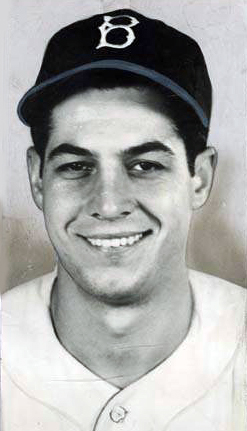The mid-twentieth century is often referred to as the “Golden Age of Baseball” in New York City. Much of that glitter came from the most populous borough of the Big Apple – Brooklyn. The period began at the conclusion of World War II and extended through the 1950s. Young Brooklyn ballplayers like Tommy Brown, Cal Abrams and Chuck Connors flourished in that time and place and later, all wore the uniform of the home team Brooklyn Dodgers. Another name from the era was Stephen Neal Lembo of Borough Park.
The Lembos, Joseph and Lucia, raised three children. Anna was their daughter and her brothers, Steve and Anthony, both became professional baseball players. The patriarch of the family, Joseph, was born in New York, but his family was Neapolitan. Lucia was born in Avellino, near Naples. The two baseball meccas in the lives of Brooklyn’s baseball youth were a just a lazy fly ball away from where Steve Lembo grew up – the Parade Ground, where there was always a confluence of sandlot baseball talent and Ebbets Field, the home of the beloved Dodgers’ ball club.
The Lembo family were parishioners of St. Catherine of Alexandria RC Church, where the boys competed in sports with the Catholic Youth Organization (CYO). At the Parade Ground, Steve and Tommy Brown both played in the Brooklyn Kiwanis League. Due to travel restrictions during the war, the Dodgers trained at Bear Mountain, New York. Here, the club conducted try-outs, often selecting boys from Brooklyn. In 1944, several were signed, two of which made it to Big Leagues. Tommy Brown (whose mom was Italian) played seven years in the majors and held the distinction at age 17, of being the youngest player to hit a home run in the majors.
Steve Lembo was another signing. A strong defensive catcher, he was sent to Newport News in the Class B Piedmont League and then to Zanesville in the Class D Ohio State League. After a stint in the Navy, he played at Johnstown in Class C ball. In ’47 he was back at Newport News and the next year sent to Pueblo in the Class A Western League. In those days, the climb to the majors was long and arduous.
He earned a promotion to Montreal for 1949. Montreal was in the AAA International league and the top affiliate of the Dodgers. He hit .291 with two home runs in 90 games and was named to the league All-Star team. As a result, he was added to the Dodgers 40-man roster that fall.
While the Dodgers always had good prospects filling their rosters, they also had one of the best and most durable catchers in their lineup – Roy Campanella (whose father was Sicilian). In the 1950 season, Steve suffered an illness and injury which cost him the entire season, playing just 21 games. However, after Campy dislocated a thumb on September 6, Lembo was called up and joined his old Brooklyn teammate, Tommy Brown. His big league debut came on the following day when he caught the Dodgers right-hander Carl Erskine. In the next two games he handled the servings of Ralph Branca and Preacher Roe and got his first major league hit.
Back in the minors in ’51, he hit .260 with two home runs in 115 games and was again brought up to the big club following another injury to Campanella. Serving primarily in the bull pen, it was Steve who had warmed up Ralph Branca prior to Bobby Thomson’s ‘Shot Heard Round the World’ in the third game of the playoffs at the Polo Grounds.
On October 20, 1951, Steve married Josephine Tedesco. He was back with Fort Worth in AA ball until another September call-up. Optioned out to Montreal the next season, a recurring back ailment kept his play limited and in February 1954, at the age of 27, Steve Lembo retired from baseball.
In an age when professional players needed to hold jobs in the off season, Lembo had gone to work with a landmark Brooklyn department store, Abraham & Strauss, some years before became the manager of the sports department full time. Working with kids through his long association with the CYO, Steve also maintained a relationship with the Brooklyn Dodgers, working as a scout and getting work for players at the department store during the winter months.
He was associated with the signings of Bob Aspromonte, Tommy Davis, Al Ferrara and later, John Franco. It was said of him, “A great scout, but even better as a human being.” He passed away on December 4, 1989.




